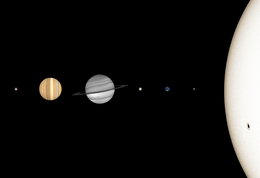Gentu System
This article is a work in progress. Any information here may not be final as changes are often made to make way for improvements or expansion of lore-wise information about Gentu. Please comment on this article's talk page to share your input, comments and questions. Note: To contribute to this article, contact User:Philimania. |
 | |
| Age | 4.931 billion years |
|---|---|
| Location | XXX |
| System mass | 1.0011 Solar masses |
| Nearest star | TBA |
| Nearest known planetary system | TBA |
| Planetary system | |
| Semi-major axis of outer known planet (Une'ara) | 35.30 AU |
| Distance to Kuiper cliff | 37 AU |
Populations | |
| Stars | 1 (Sun) |
| Known planets | |
| Known dwarf planets | TBA |
| Known natural satellites | 2,000+ |
| Known minor planets | TBA |
| Known comets | TBA |
| Identified rounded satellites | TBA |
| Orbit about Galactic Center | |
| Invariable-to-galactic plane inclination | 60.19° (ecliptic) |
| Distance to Galactic Center | 27,000 ± 1,000 ly |
| Orbital speed | 220 km/s; 136 mi/s |
| Orbital period | 225–250 myr |
| Star-related properties | |
| Spectral type | G2V |
| Frost line | ≈5 AU |
The Gentu System is the gravitationally bound system of the Sun and the objects that orbit it. The Gentu System formed 4.9 billion years ago from the gravitational collapse of a giant interstellar molecular cloud. The vast majority of the system's mass is in the Sun, with most of the remaining mass contained in the planet Trenas. The three inner system planets, Gumaya, Gentu, and Isthylon are terrestrial planets, being composed primarily of rock and metal. The two giant planets of the outer system, Enera and Trenas are substantially larger and more massive than the terrestrials. They are gas giants, being composed mainly of hydrogen and helium. The planet Une'ara is the outest planet of the Gentu System which, like the planets of the inner system, is composed primarily of rock and metal.
Formation
TBA
Sun
TBA
Planet
Inner Gentu System
Gumaya
TBA
Gentu
TBA
Isthylon
TBA
Inner belt
TBA
Outer Gentu System
Enera
TBA
Trenas
TBA
Une'ara
TBA
Outer belt
TBA
Comets
TBA
Human discovery & exploration
TBA

